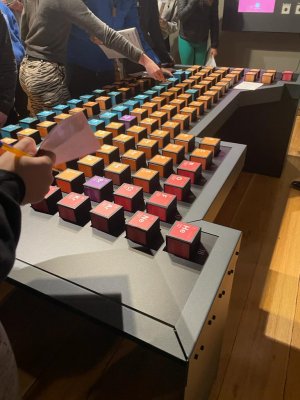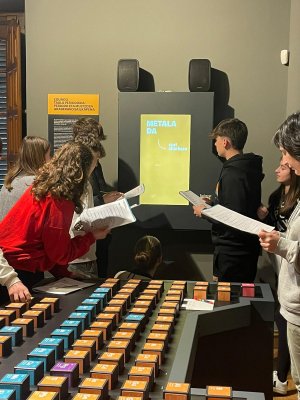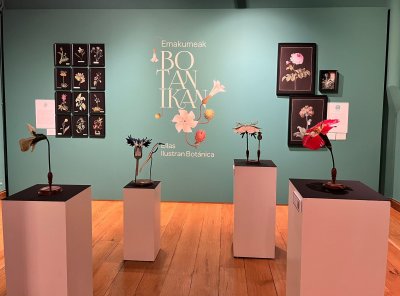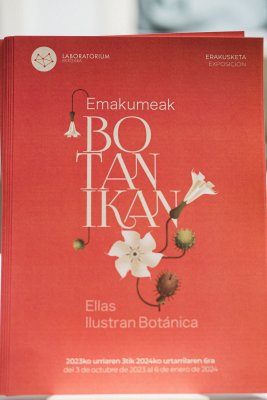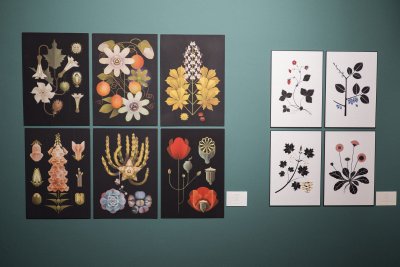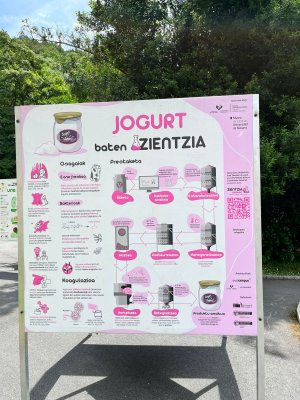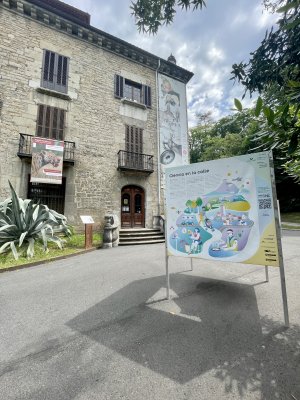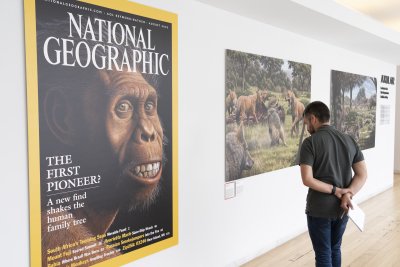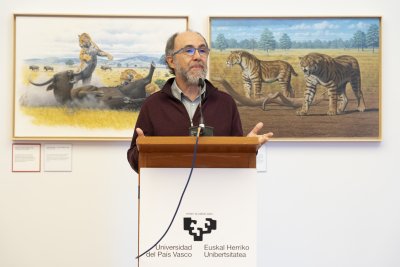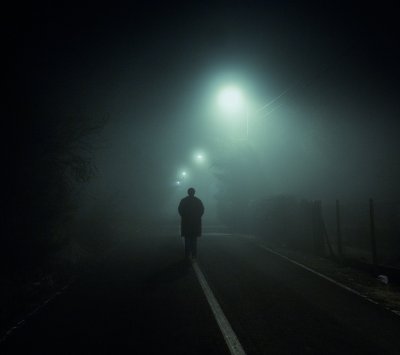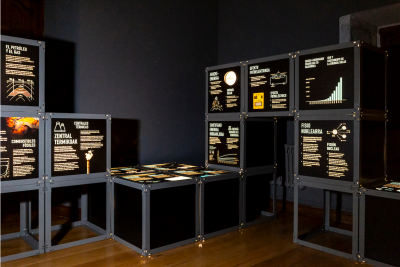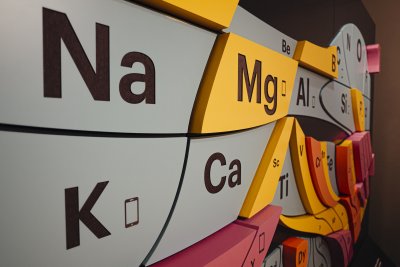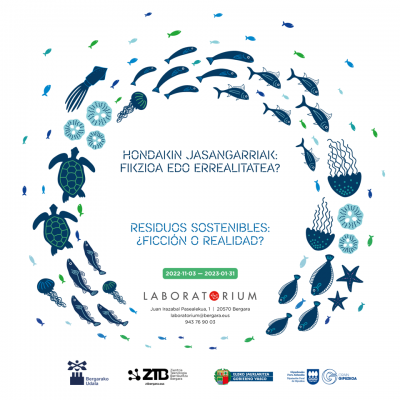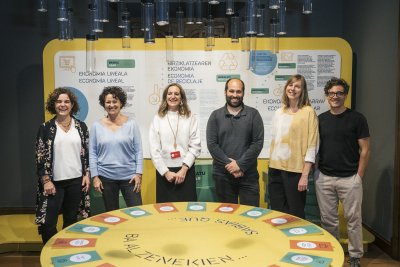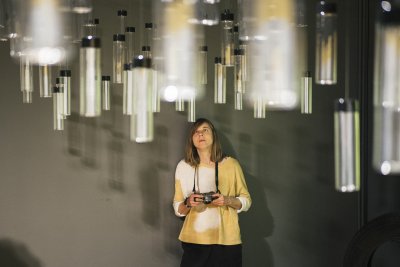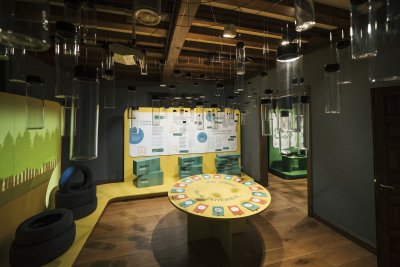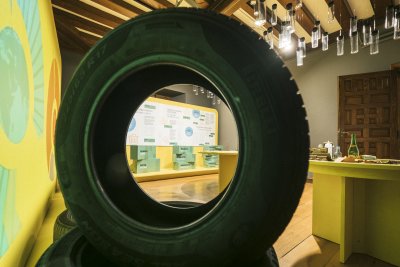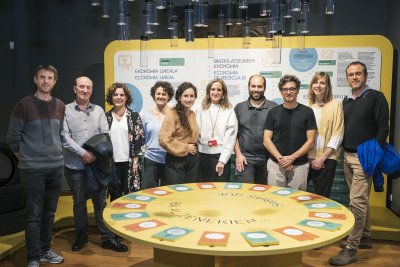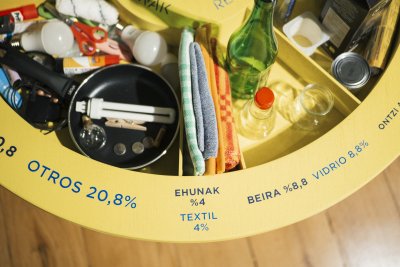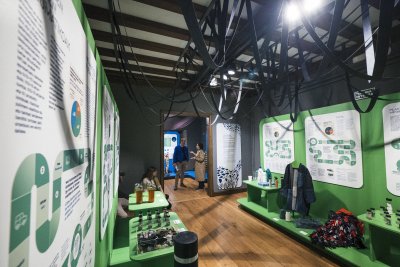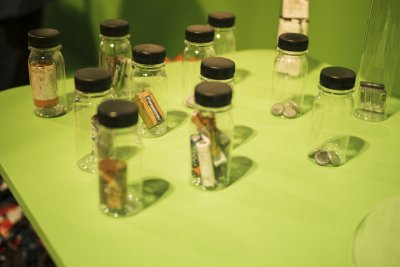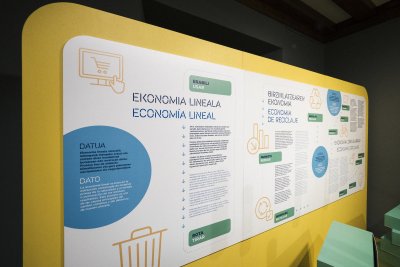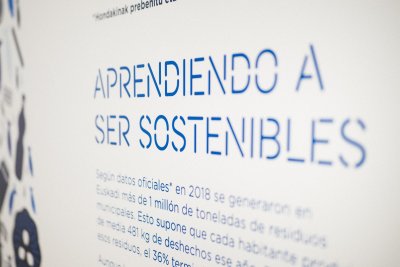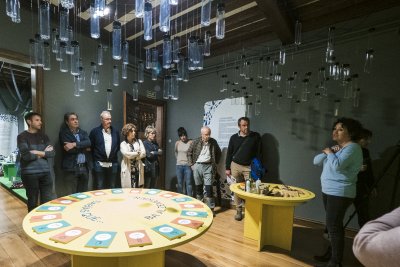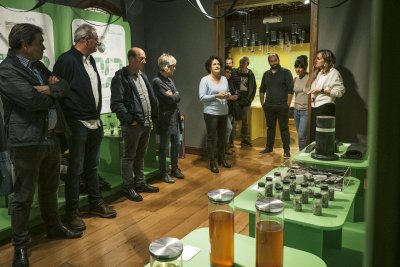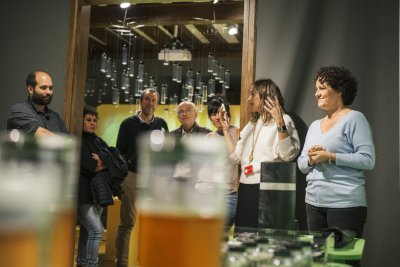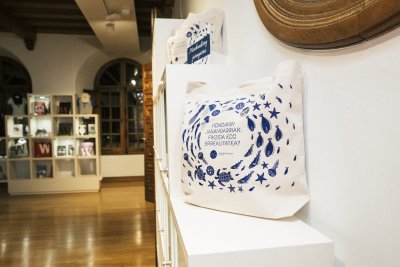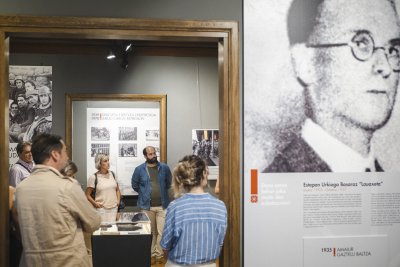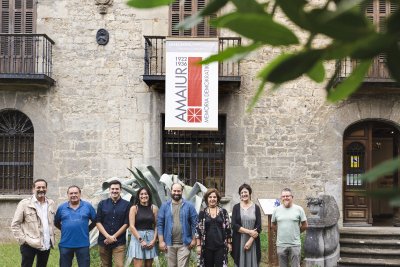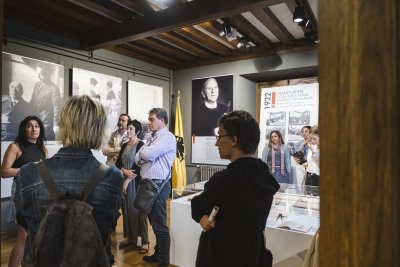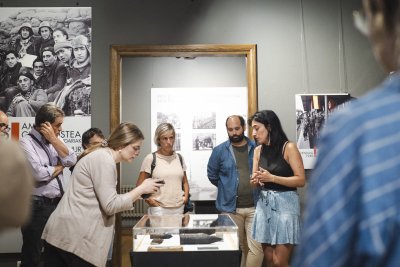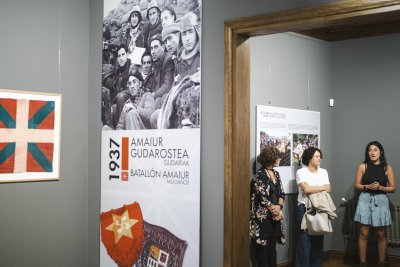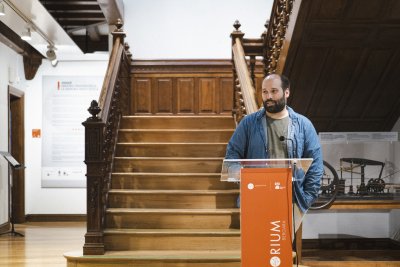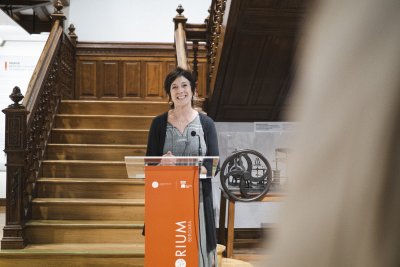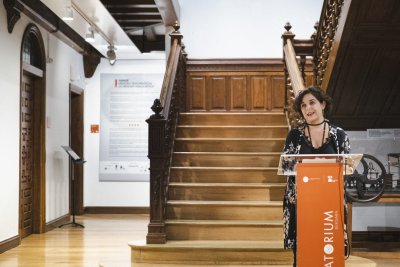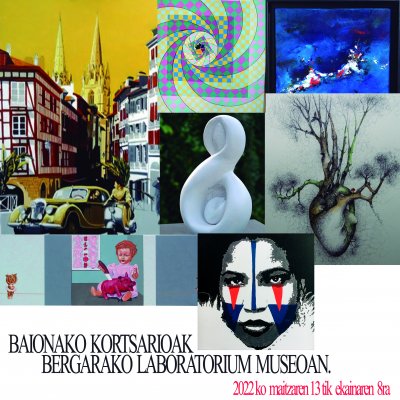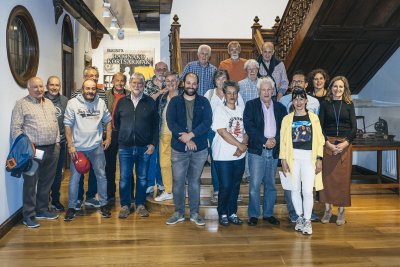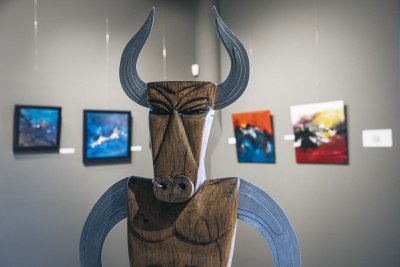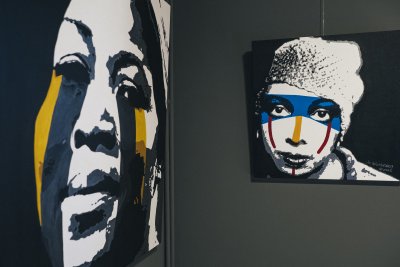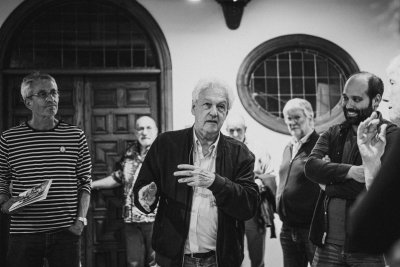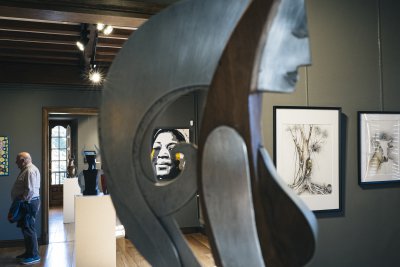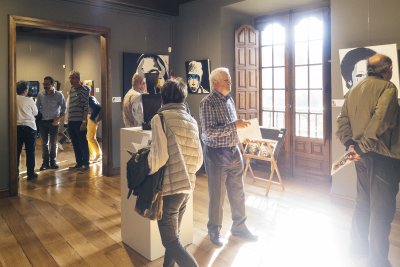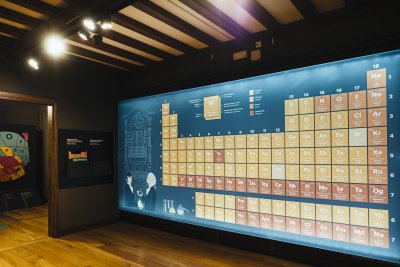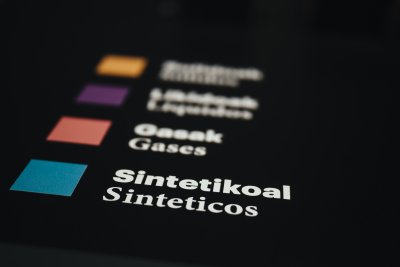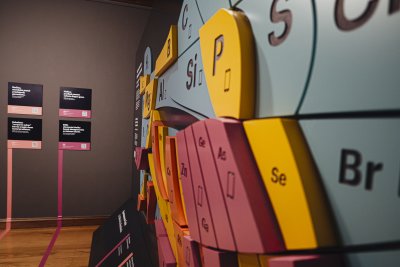Temporary exhibitions
Periodic Table 2024: Elements that explain the Universe
Erakusketa
In 2019/2020, the museum held an ambitious exhibition on the Periodic Table, coinciding with the anniversary of the invention. In this exhibition, visitors can learn about the chemical components that make up our world and their organization, learn the relationship of chemical elements with humans and nature, as well as the history of chemical discoveries.
In this exhibition, we show the visitor the importance of the invention of the periodic table and pay tribute to the Elhuyar brothers, who in 1783, managed to isolate tungsten in the facilities of the Chemical Laboratory created in 1778 associated with the Bascongado Patriotic Seminary of Bergara.
Room 1: Evolution of the Periodic Table
The creation of the periodic table is one of the most representative milestones in the history of science. In this first room, the periodic table is presented in interactive format, its function and its evolution until reaching its current configuration and the characteristics of each of the chemical elements that compose it.
Room 2: Discovery of tungsten and the Elhuyar brothers
Scientific research proposes to provide new facts, data, relationships or laws. In Bergara, it was the Elhuyar Hermoans who, through a scientific method, managed to isolate tungsten in 1783. This second space is dedicated to the discovery of tungsten and the importance of Bergara in this finding.
Room 3: The Table of Abundance
In the last room we will know the Table of Abundance, created by the European Chemical Society (EuChemS) and presented at the European Parliament in 2019. This periodic table collects the natural chemical elements and represents the abundance or scarcity of each of them on Earth. The table of abundance will help us understand which resources we should protect, as they are at serious risk of supply in the coming years.
Emakumeak Botanikan. Artea, zientzia eta generoa
Erakusketa
Erakusketa honek xvii. mendetik gaur egunera arte emakume botanika ilustratzaile zientifikoen
lana erakusten du, artearen, zientziaren eta generoaren arteko harremanak azalduz.
Ibilbidea ilustrazio zientifikoaren historiaren aurkezpenarekin hasten da marrazketa eta
grabatu klasikoaren emakume garrantzitsuenetako batzuen eskutik, normalean artisten
familietakoak zirenak. Ondoren, xviii. mendetik aurrera, beste kontinente batzuetara
egindako bidaiei eta landare exotikoen aurkikuntzari esker, ikonografia botanikoa hedatu
egin zela ikus daiteke. Garai horretan agertu ziren espedizio zientifikoetan murgilduz
beren garaiko rola zalantzan jartzeko gai ziren lehen emakumeak. Jarraian, xix. mendetik
aurrera ikonografia botanikoa zabaldu egin zen argazkigintza, mikroskopioa, X izpiak edo
eskanerra bezalako teknologiei esker, eta emakumeak ere aitzindariak izan ziren tresna horiek
erabiltzen. xx. mendeko sortzaileen artean, haien prestakuntza zientifiko eta artistiko sendoa
nabarmentzen da, eta horrek iruditeria botanikoa espezializatzea eragiten du. Erakusketa xxi.
mendeko sortzaile gazteen irudiekin amaitzen da, tresna digitalekin lan egiten dutenak eta
zientzia adin guztietarako zabaltzen dutenak.
Erakusketa honetan aurkezten diren lanen ezaugarri komuna haien balio estetikoan datza,
emakumeek botanika irudikatzeko izan duten sentsibilitate artistikoan, zientzia artea
eta artea zientzia izan daitezkeela erakutsiz. Baina, gainera, beren biografien bidez, haiek
berdintasunaren bideak nola zabaldu zizkiguten ere erakusten digu.
Zientzia kalean
Erakusketa
https://youtube.com/shorts/rXNPL8z6ybc
Zientzia kalean erakusketak zientzia gizarteratzea du helburu. Ikuspegi zientifikotik egunero erabiltzen ditugun gailuen funtzionamendua eta kontsumitzen ditugun produktuen konposizioa azaltzen du. Esperientzia osatzeko QR kode baten bitartez irudiak deskargatzeko aukera dago.
Ikusi ditzakegun irudien artean egunero inguruan ditugun, erabiltzen edo kontsumitzen ditugun produktuen azalpen zientifikoa eskaintzen da. Infografien bitartez mugikorren, barra kodeen, txertoen, iturriko uraren eta sukaldeko plaken funtzionamendua azaltzen da. Horretaz gain, jogurten, garagardoaren, zuhaitzen hostoen, ogi barren edo fruituen konposizioaren inguruko azalpenak eskaintzen dira.
Zientzia Kalean Euskal Herriko Unibertsitatearen Kultura Zientifikoko Katedraren eta Nafarroako Unibertsitateko Zientzia Museoaren egitasmoa da eta UPV/EHUko Ikerketa Gizartera Zabaltzeko Zuzendaritzaren eta Euskampus Fundazioaren lanari esker jarri da martxan.
“Kultura zientifikoa giza kulturaren parte da. Zientziak eskainiko dizkigu gizarte bezala erabakiak hartzeko beharrezko ezagutzak eta irizpideak. Hori dela eta oraingoan, herritarrak ekitaldi batera gonbidatu beharrean, zientzia haiengana hurbildu dugu. Kultura zientifikoa espazio publikoan txertatzean interesa daukanari bidea erraztu diogu eta, agian, beste batzuei interesa piztu diegu”, azpimarratu du Perez Iglesiasek UPV/EHU Kultura Zientifikoko Katedrako arduradunak.
Ekainak 7tik uztaila 28arte ikusgai egongo da Laboratorium Museoaren lorategian.
Illustrating the Past: Mauricio Antón and Paleoart
Erakusketa
The exhibition, which includes works by the paleontological illutrator, it will can be visited at the Laboratorium Museum from June 2.
In the exhibition, you can see the species of hominins and other animal figures that do not exist today and the process of creating them through the works of Mauricio Antón.
Energia: Guzti-guztiaren jatorria eta amaiera
Erakusketa
For two centuries we have been squeezing our planet's energy resources. Increasing living standards means increasing energy consumption, which is also being multiplied by the galloping population growth. We will have enough energy to continue this unbridled race?
ENERGY: ORIGIN AND END OF EVERYTHING
How can it be that the energy of the Universe is zero?
What is its role in its evolution, and in the role of humanity?
How does it relate to the quality of life? what about the level of our economies? climate change?
In addition to putting numbers to the values of energy in its different manifestations and scenarios, from manoscopic to cosmological, the use of the different available fuels and their future is emphasised.
1st ROOM: UNIVERSE AND HUMANITY
What decisions will we have to make about energy use in the immediate future?
Complexity, information, evolution, chaos, dark energy, international relations, transport, climate change, population and cities are the protagonists of this first story.
Their relationship with energy has been, is and will be crucial to understanding what we are and what we will be.
2nd ROOM: ENERGETIC ENVIRONMENTS
Energy manifests like a chamaleon, because it takes on many different forms and can transform from one to another without diminishing
We will go through different scales ranging from the nanoscopic to the cosmological world. Energy is what moves the Universe at all levels
3rd ROOM: FUELS AND ENERGY GENERATION
Do we have enough energy to continue to involve and pursue the goal of going further in almost every area of our lives?
The exhibition endeavours to explain the use of all the fuels that are used to produce electricity, work, movement, order and information.
TO SEE THE EXHIBITION ONLINE CLICK HERE (Spanish)
Periodic Table 2023: Elements that explain the Universe
Erakusketa
In 2019/2020, the museum held an ambitious exhibition on the Periodic Table, coinciding with the anniversary of the invention. In this exhibition, visitors can learn about the chemical components that make up our world and their organization, learn the relationship of chemical elements with humans and nature, as well as the history of chemical discoveries.
In this exhibition, we show the visitor the importance of the invention of the periodic table and pay tribute to the Elhuyar brothers, who in 1783, managed to isolate tungsten in the facilities of the Chemical Laboratory created in 1778 associated with the Bascongado Patriotic Seminary of Bergara.
Room 1: Evolution of the Periodic Table
The creation of the periodic table is one of the most representative milestones in the history of science. In this first room, the periodic table is presented in interactive format, its function and its evolution until reaching its current configuration and the characteristics of each of the chemical elements that compose it.
Room 2: Discovery of tungsten and the Elhuyar brothers
Scientific research proposes to provide new facts, data, relationships or laws. In Bergara, it was the Elhuyar Hermoans who, through a scientific method, managed to isolate tungsten in 1783. This second space is dedicated to the discovery of tungsten and the importance of Bergara in this finding.
Room 3: The Table of Abundance
In the last room we will know the Table of Abundance, created by the European Chemical Society (EuChemS) and presented at the European Parliament in 2019. This periodic table collects the natural chemical elements and represents the abundance or scarcity of each of them on Earth. The table of abundance will help us understand which resources we should protect, as they are at serious risk of supply in the coming years.
Sustainable waste: fiction or reality?
Erakusketa
GUIDED TOURS AT CHRISTMAS
- December 26: 11:00 in basque; 17:00 in spanish
- December 27: 11:00 in spanish; 17:00 in basque.
Guide: Janire Lamariano. Organic chemistry doctor.
Within the framework of the ZTB Conference, on november 3 the exhibition "Sustainable waste: fiction or reality" has opened, wich will remain in the temporary exhibition hall until January 31, 2023. The mayor of Bergara, Gorka Artola, and the person in charge of Laboratorium, Rosa Errazkin, highlighted and thanked in their interventions the collaboration of the agents who have contributed to the realization of the exhibition. Sustainability is the central theme addressed in the year´s ZTB conferences.
Susana Pérez, Pedro Mujika from Industrias Mujika and Iñigo Isasti from Jolas have collaborated in the exhibition; and Adriana Uribesalgo, from the company Kafea Eco, gave an account of the work being carried out in this line, coinciding with the exhibition route.
There are many signs that show that our way of life is no longer sustainable: climate change, pollution rates, overexploitation of resources, water shortage... The transition towards a new model based on recycling, reuse, repair and recovery is a challenge and a duty that we must all assume as soon as possible.
This exhibition has been planned as an introductory journey through the recycling and reuse of hausehold waste with the aim of showing that the change towards an alternative model of production and consumption that is respectful of the natural environment is possible.
The exhibition tells us about recovery, renewal and repair, working on each idea in a room.
RECOVER - REDESIGN - RENEW - REPAIR - REUSE - REDUCE - RECYCLE
ROOM 1
Room 1 proposes a journey through the three production system that we humans have generally put into practice since the Industrial Revolution, namely the linear production system, recycling and the circular economy
In this introductory room we will find the fundamental keys to understand the differences between each of them through manipulative games, graphic diagrams and a magnificent audiovisual presentation provided by the Ellen McArthur Foundation.
ROOM 2
In Room 2 we present examples of 6 types of waste that can be recycled and reused through different processes and strategies. Here we will learn that an old tire, a torn jacket or the used oil we get every day after cooking can have a new life cycle as a raw material to manufacture other products. The potential of waste is incredible!
ROOM 3
In the last room of the exhibition we will learn about some success stories carried out in the Basque Country. We refer to business initiatives, some very young and recent and others with history of more than a century and a half of existence, which have been able to find in recycling and circular economy fruitfull way to develop proposals for the future that make economic development compatible with sustainability.
Amaiur 1922-1936. Memoria demokratikoa
Erakusketa
An exhibition on Amaiur's democratic memory opens at the Laboratorium museum in Bergara.
From 20 June, the Laboratorium Museum in Bergara will be hosting the exhibition 'Amaiur 1922-1936 Democratic Memory'. It is a temporary exhibition that narrates the historical trajectory of this reference place of memory in our history. It will be in Bergara between June 20 and September 11.
The exhibition is organized by the Laboratorium Museum, the Olaso Tower Foundation and the Bergara City Council, and curated by the Aranzadi Science Society. Representatives of the four entities participated in the presentation made at the laboratorium.
The deputy mayor of Bergara, Ainhoa Lete, has made reference to the social nature of the Museum and the collaboration between the different agents. "At Laboratorium we are used to holding science-related exhibitions and we associate our activity especially with science, innovation and technology, but the museum also goes beyond that, and makes room for our history, art... making many other subjects available to the public through dissemination. In relation to this exhibition, I would also like to highlight the idea of collaboration that we have mentioned on so many other occasions.
The Mayor of Bergara, Gorka Artola, links the exhibition to the work being carried out by Bergara Town Council in the recovery of memory. "We are working to build the Bergara of the future, but to move forward it is essential to look back, to know the history, to recognise it, to recover memory. In Bergara we are working in this sense, among others, with Aranzadi, and now we are going to make room for the history of Euskal Herria through the museum."
The Laboratorium received the proposal for this exhibition through the foundation the Olaso Tower Foundation. Maite Aristegi, member of the Foundation's Board of Trustees, said that "Amaiur is an essential symbol of the Basque narrative, which explains how far we Basques are willing to go in defence of our freedoms. As Lauaxeta said, everything mus be given to the beloved freedom, and that is what the members of the Amaiur battalion did in the Amaiur castle and did again in the war of 1936"
Maite Errarte, from the Aranzadi Science Society, explained the details of the exhibition. She stresses that the construction of the Amaiur monolith or the fact that "a battalion of the Basque Army that is called Amaiur is no coincidence. Amaiur is a space present in our collective imagination and this exhibition aims to go to the roots and to the reason for the formation of that memory. Places of memory emerge between history, truth and myth, from which each of us creates our own narratives obout them."
Amaiur, a place of memory
Every country in the world has places of memory around which, for various reasons, feelings of all kinds are concentrated, sometimes conflicting, but which arouse the interest of citizens. Amaiur is one of them. It is when a historical place arouses so many different feelings that it acquires its full symbolism and dimension as a place of memory.
The aim of this exhibition is to present in a synthetic way how Amaiur was understood by a generation that fought for the defence of democratic freedoms and the Republic at the beginning of the 20th century. This is the case of such important figures in history as the humanist and politician Arturo Campión (1854-1937); the writer and politician Telesforo Monzón (1904-1981); or the politician and feminist Bittori Etxeberria (1908-1997)
Likewise, one of the battalions that took part in the resistance during the Civil War was given the name of "Amayur"; this was an act of homage to the resistance that defended the castle of Amaiur against the best militarily trained troops and was loyal to the legitimate regime, in the context of the conquest of Kingdom of Navarre.
This exhibition aims to be a humble gesture of reparation to recognise the suffering and the violation of the human rights of all those people, mostly anonymous, who assimilated the resistance of Amaiur to their resistance to Franco's military uprising. This was undoubtedly the generation that made Amaiur a place of memory.
The exhibition is supported by several organisations
It has the collaboration of the Gaztelu Society of Amaiur, the village of Amaiur, the Baztan Town Council, The Ministry of Culture and Sport of the Spanish Government, the Sabino Arana Foundation, Irujo Etxea, the Javier Ciga Foundation, the Department of Basque Studies of the University of Nevada and the University of the Basque Country.
Guided tours
During the months of July and August, 11:00 and 12:30. This offer will be added to the 5 options offered by the Bergara tourist office and it will be up to the people who are there at the time to choose which one to take. They can also be expressly requested in advance, like the rest of the guided tours.
The corsairs of Baiona
Erakusketa
Once again this year, and thanks to their relationship with the Beart Association of Bergara, Baionako Kortsarioak are exhibiting their works in Bergara. This year, however, they will have a new location: the Laboratorium Museum. The exhibition will be in Bergara from 13 May to 8 June.
From the banks of the Errobi and the Adour, Alain, Andre, Claude, Eric, Julia, Mica and Pat shows us their creations made in timps of pandemic in Bergara. They are works that are already very familiar to us because we are getting to know the artist and his work better and better.
In these difficult times we have lived through, art shows us its kindest face and serves as a healing tool, a refuge where we can express what we see and experience that we can hardly express in any other way.
Baiona Bergara, Bergara Baiona, a round trip but it goes much further, with art we participate in a journey to emotional, psychological and spiritual freedom. Let's enjoy this exhibition that 'Baionako Kortsarioak' have prepared with so much attention.
Opening
Beart alkartearekin elkarlanean egin dugun erakusketa honen inaugurazioa maiatzaren 13an izan genuen.
The Mayor Gorka Artola welcomed the artists of the 'Galerie de Corsaires' of Baiona, where the Deputy Mayor Ainhoa Lete, the head of the Laboratorium Museoa Rosa Errazkin, the president of Beart Karlos Galarraga and the head of the Association 'Les Corsaires' André Goupille were also present.
The mayor highlighted the social character of the museum. He said that it is not only linked to science and that it has recently hosted exhibitions with a wide variety of themes. "It is a social museum and its contribution, like society, is diverse and varied. This is also attested to by the exhibitions it hosts".
The mayor also referred to the presence of art in Bergara and the great work carried out by Beart in this field.
"Art has shown us its most pleasant side in these difficult times we have lived through and has helped us to heal. Art is a refuge that allows us to express what we see and what we experience, because otherwise it would be difficult for us to express all this", says Karlos Glarraga, president of the Beart Association.
Rosa Errazkin, head of the Laboratorium Museoa, also highlighted the idea of collaboration.
'Galerie de Corsaires' is a non-profit association that collaborates with the City Council of Baiona. It is located in the heart of Baiona Ttipia, near the Basque Museum and Bonnat-Helleu, and offers artists from the Basque Country and the Southwest of France the possibility to exhibit their works free of charge. It occasionally organises exhibitions in connection with local events such as the Ham Fair, Diversity Week, Museum Night and Blue Week (painting competition for seniors).
It also engages with artists' collectives abroad to collaborate and maintain relationships. The 'Galerie des Corsaires' participates in open-air exhibitions, as well as organising an annual open-air event such as 'Remp' Arts'.
They welcome their presence in Bergara and also their new location for the exhibition.
Taula periodikoa 2022: unibertsoa osatzen duten elementuak
Erakusketa
2019/2020an, museoak anbizio handiko erakusketa egin zuen Taula Periodikoari buruz, asmakuntzaren urteurrenarekin batera. Erakusketa horretan, bisitariek gure mudua osatzen duten osagai kimikoak eta horien antolaketa ezagutu dezakete, elementu kimikoek gizakiarekin eta naturarekin daukaten harremana ikasten dute, eta kimikarien aurkikuntzen historiaz jabetu daitezke ere.
Aurten erakusketa hori berreskuratu dugu, eta, aipatutakoaz gain, panelei eta jolas didaktikoei esker, Dimitri Ivanovich Mendeleiev zientzialari errusiarrak, 1869an, gaur egun erabiltzen dugun taula periodikoa sortu zuela gogoratuko dugu. Taula Periodikoaren asmakuntzak izan duen garrantzia azpimarratzen dugu, eta, aldi berean, Elhuyar anaiak omentzen ditugu, 1783an Wolframa isolatu baitzuten, 1778an Real Seminario Patriótico Bascongadoko elkarteak Bergaran sortutako Laboratorium Chemicum-ean.
1. Aretoa: Taula periodikoaren bilakaera
Taula periodikoaren sorrera zientziaren historiako jazoera adierazgarrietako bat da. Lehendabiziko aretoan taula periodikoa dago erakusgai modu interaktiboan. Hala, haren funtzioa eta haren bilakaera azaltzen dira egun duen konfiguraiora iritsi arte. Gainera, hura osatzen duten elementu kimiko bakoitzaren ezaugarraik ageri dira.
2. Aretoa: Wolframaren aurkikuntza eta Elhuyar anaiak
Ikerketa zientifikoak gertaera, datu, erlazio edo lege berriak ematea proposatzen du. Bergaran Elhuyar anaiek wolframio isolatzea lortu zuten 1783. urtean metodo zientifiko bat erabiliz. Bigarren eremu honetan wolframioaren aurkikuntza eta Bergarak aurkikuntza horretan izandako garrantzia jorratzen dira.
3. Aretoa: Oparotasunaren taula
Azken areto honetan ezagutuko dugu Kimikako Europako Elkarteak (EuChemS) sortu eta Europako Parlamentuan 2019an aurkeztutako Oparotasunaren Taula. Taula periodiko horretan elementu kimiko naturalak jasotzen dira eta horietako bakoitza Lurrean oparoa ala urria den islatzen da. Oparotasunaren taula lagungarri izango zaigu zein baliabide babestu behar ditugun ulertzeko, izan ere, datozen urteetan horien hornidura arrisku larrian dago.





